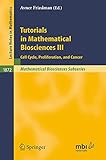Tutorials in Mathematical Biosciences III [electronic resource] : Cell Cycle, Proliferation, and Cancer / edited by Avner Friedman.
Material type: TextSeries: Lecture Notes in Mathematics ; 1872Publisher: Berlin, Heidelberg : Springer Berlin Heidelberg, 2006Description: VII, 246 p. online resourceContent type: text Media type: computer Carrier type: online resourceISBN: 9783540324157Subject(s): Mathematics | Differential Equations | Differential equations, partial | Biology -- Mathematics | Physiology -- Mathematics | Mathematical optimization | Mathematics | Mathematical Biology in General | Ordinary Differential Equations | Partial Differential Equations | Calculus of Variations and Optimal Control; Optimization | Physiological, Cellular and Medical TopicsAdditional physical formats: Printed edition:: No titleDDC classification: 570.151 LOC classification: QH323.5Online resources: Click here to access online
TextSeries: Lecture Notes in Mathematics ; 1872Publisher: Berlin, Heidelberg : Springer Berlin Heidelberg, 2006Description: VII, 246 p. online resourceContent type: text Media type: computer Carrier type: online resourceISBN: 9783540324157Subject(s): Mathematics | Differential Equations | Differential equations, partial | Biology -- Mathematics | Physiology -- Mathematics | Mathematical optimization | Mathematics | Mathematical Biology in General | Ordinary Differential Equations | Partial Differential Equations | Calculus of Variations and Optimal Control; Optimization | Physiological, Cellular and Medical TopicsAdditional physical formats: Printed edition:: No titleDDC classification: 570.151 LOC classification: QH323.5Online resources: Click here to access online  E-BOOKS
E-BOOKS
| Current library | Home library | Call number | Materials specified | URL | Status | Date due | Barcode |
|---|---|---|---|---|---|---|---|
| IMSc Library | IMSc Library | Link to resource | Available | EBK34 |
Modeling the Cell Division Cycle (B. Aguda) -- Angiogenesis - A Biochemical/Mathematical Prospective (H. A. Levine and M. Nilsen-Hamilton) -- Spatio-Temporal Models of the uPA System and Tissue Invasion (G. Lolas) -- Mathematical Modeling of Spatio-Temporal Phenomena in Tumor Immunology (M. Chaplain and A. Matzavinos) -- Control Theory Approach to Cancer Chemotherapy: Benefiting from Phase Dependence and Overcoming Drug Resistance (M. Kimmel and A. Swierniak) -- Cancer Models and their Mathematical Analysis (A. Friedman).
This volume introduces some basic mathematical models for cell cycle, proliferation, cancer, and cancer therapy. Chapter 1 gives an overview of the modeling of the cell division cycle. Chapter 2 describes how tumor secretes growth factors to form new blood vessels in its vicinity, which provide it with nutrients it needs in order to grow. Chapter 3 explores the process that enables the tumor to invade the neighboring tissue. Chapter 4 models the interaction between a tumor and the immune system. Chapter 5 is concerned with chemotherapy; it uses concepts from control theory to minimize obstacles arising from drug resistance and from cell cycle dynamics. Finally, Chapter 6 reviews mathematical results for various cancer models.


There are no comments on this title.